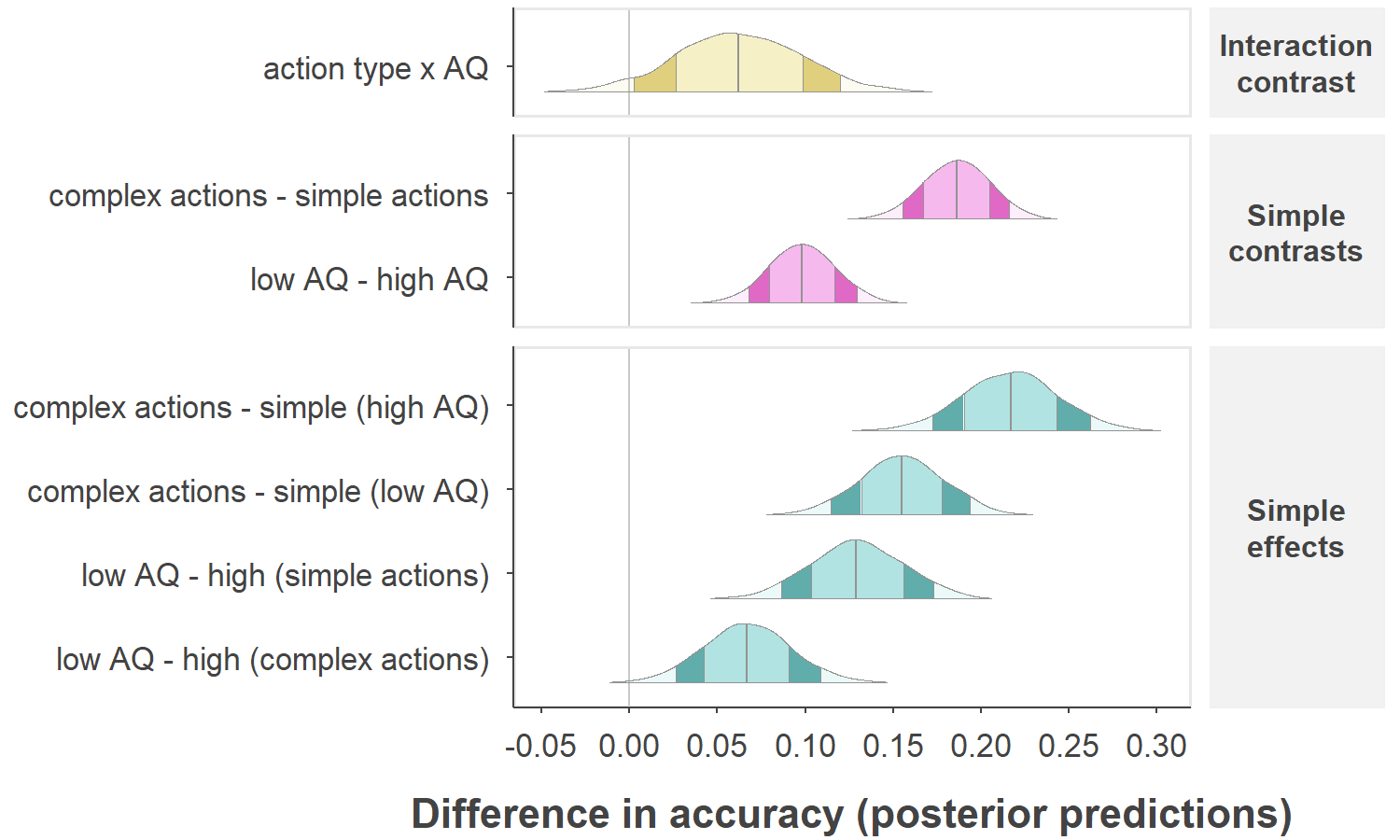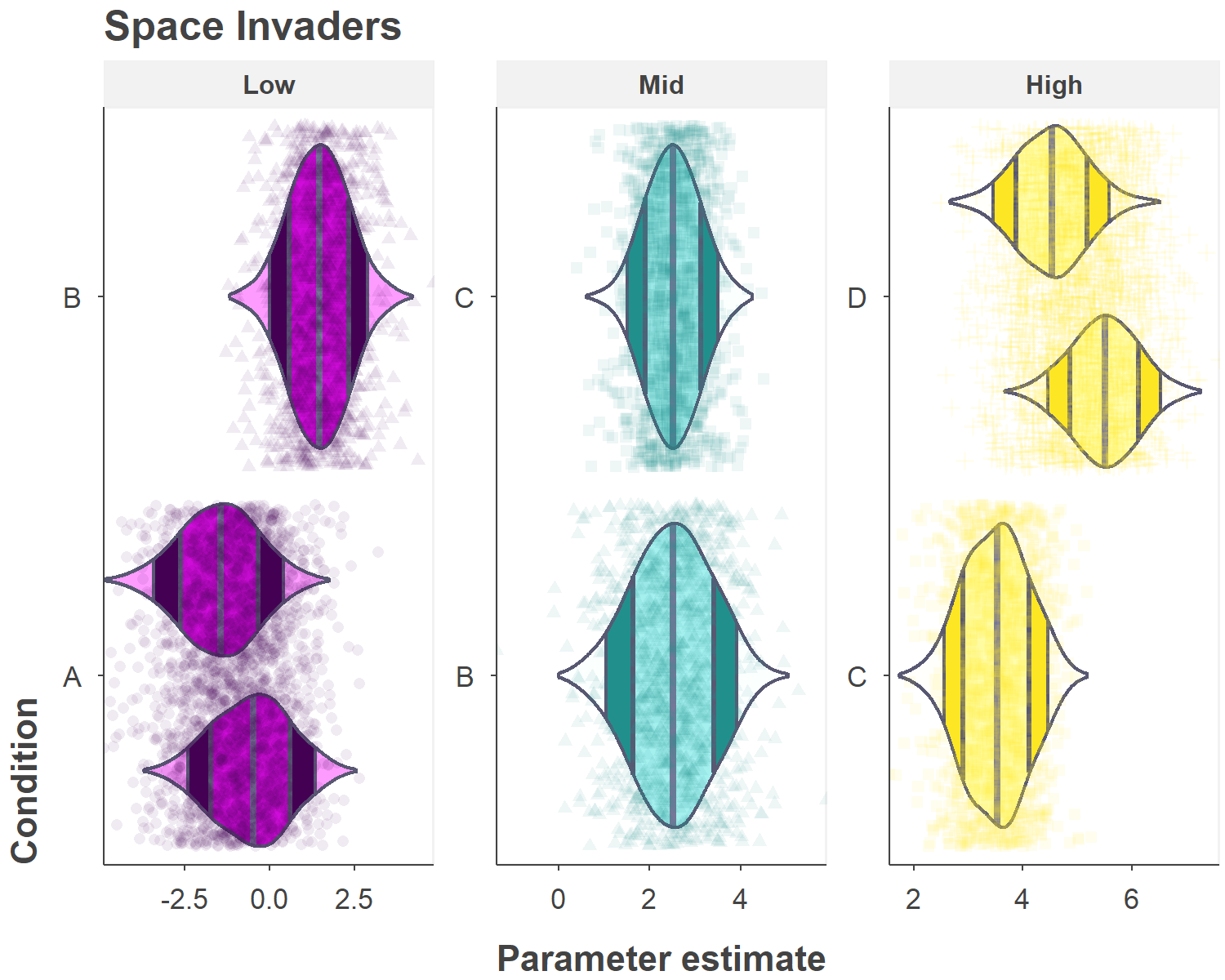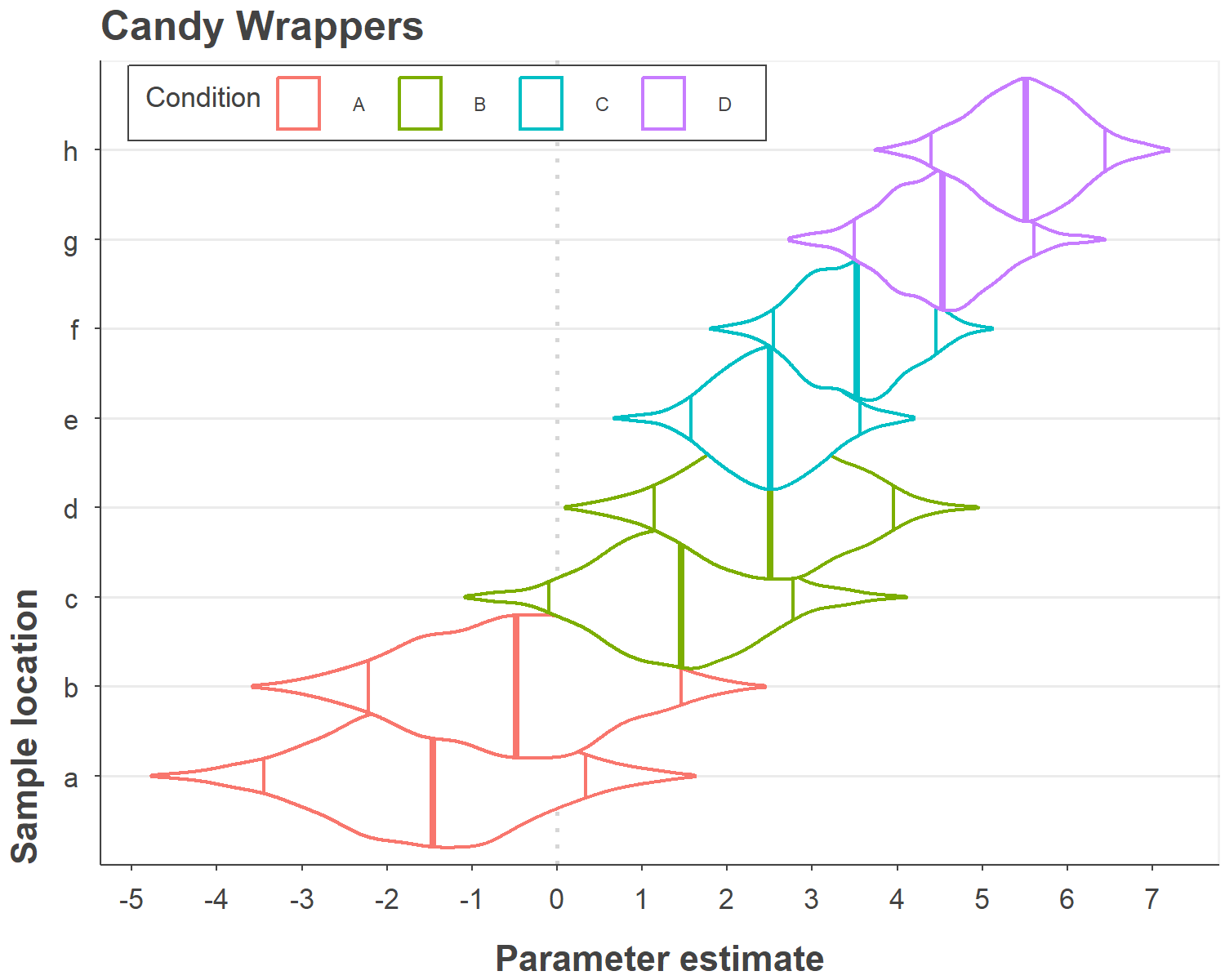iamamutt / Ggdistribute
Programming Languages
Projects that are alternatives of or similar to Ggdistribute
ggdistribute
A ggplot2 Extension for Plotting Unimodal Distributions
The ggdistribute package is an extension for plotting posterior or
other types of unimodal distributions that require overlaying
information about a distribution’s intervals. It makes use of the
ggproto system to extend ggplot2, providing additional “geoms”,
“stats”, and “positions.” The extensions integrate with existing
ggplot2 layer elements.
Example
The package function example_plot() is an overview of combining
ggdistribute with other ggplot2 elements. The contents of this
function are printed below and gives details about the extended parts to
ggplot2.
library(ggplot2)
library(ggdistribute)

example_plot <-
function() {
# color palette
colors <- mejr_palette()
ggplot(sre_data(5000), aes_string(y="effect")) +
# ggdistribute specific elements -------------------------------------------
geom_posterior(
# ~~~~~~~~~~~~~~~~~~~~~~~~~~~~~~~~~~~~~~~~~~~~~~~~~~~~~~~~~~~~~~~~~~~~~~~~
# geom_posterior() aesthetics mappings
# ~~~~~~~~~~~~~~~~~~~~~~~~~~~~~~~~~~~~~~~~~~~~~~~~~~~~~~~~~~~~~~~~~~~~~~~~
aes_string(x="value", fill="contrast"),
# ~~~~~~~~~~~~~~~~~~~~~~~~~~~~~~~~~~~~~~~~~~~~~~~~~~~~~~~~~~~~~~~~~~~~~~~~
# options passed to stat_density_ci() for estimating intervals
# ~~~~~~~~~~~~~~~~~~~~~~~~~~~~~~~~~~~~~~~~~~~~~~~~~~~~~~~~~~~~~~~~~~~~~~~~
interp_thresh=.001, # threshold for interpolating segment gaps
center_stat="median", # measure of central tendency
ci_width=0.90, # width corresponding to CI segments
interval_type="ci", # quantile intervals not highest density interval
# ~~~~~~~~~~~~~~~~~~~~~~~~~~~~~~~~~~~~~~~~~~~~~~~~~~~~~~~~~~~~~~~~~~~~~~~~
# options passed to stat_density_ci() for estimating density
# ~~~~~~~~~~~~~~~~~~~~~~~~~~~~~~~~~~~~~~~~~~~~~~~~~~~~~~~~~~~~~~~~~~~~~~~~
bw=".nrd0", # bandwidth estimator type
adjust=1.5, # adjustment to bandwidth
n=1024, # number of samples in final density
trim=.005, # trim `x` this proportion before estimating density
cut=1.5, # tail extension for zero density estimation
# ~~~~~~~~~~~~~~~~~~~~~~~~~~~~~~~~~~~~~~~~~~~~~~~~~~~~~~~~~~~~~~~~~~~~~~~~
# geom_posterior() options
# ~~~~~~~~~~~~~~~~~~~~~~~~~~~~~~~~~~~~~~~~~~~~~~~~~~~~~~~~~~~~~~~~~~~~~~~~
draw_ci=TRUE, # toggle showing confidence interval parts
draw_sd=TRUE, # toggle showing standard deviation parts
mirror=FALSE, # toggle horizontal violin distributions
midline=NULL, # line displaying center of dist. (NULL=aes color)
brighten=c(3, 0, 1.333), # additive adjustment of segment fill colors
# ~~~~~~~~~~~~~~~~~~~~~~~~~~~~~~~~~~~~~~~~~~~~~~~~~~~~~~~~~~~~~~~~~~~~~~~~
# position_spread() options
# ~~~~~~~~~~~~~~~~~~~~~~~~~~~~~~~~~~~~~~~~~~~~~~~~~~~~~~~~~~~~~~~~~~~~~~~~
position=position_spread(
reverse=TRUE, # order of spreaded groups within panels
padding=0.3, # shrink heights of distributions
height="panel" # scale by heights within panels
), #
# ~~~~~~~~~~~~~~~~~~~~~~~~~~~~~~~~~~~~~~~~~~~~~~~~~~~~~~~~~~~~~~~~~~~~~~~~
# standard ggplot layer options
# ~~~~~~~~~~~~~~~~~~~~~~~~~~~~~~~~~~~~~~~~~~~~~~~~~~~~~~~~~~~~~~~~~~~~~~~~
size=0.15, color=colors$gray, vjust=0.7, show.legend=FALSE
) +
# standard ggplot2 elements ------------------------------------------------
geom_vline(alpha=0.5, color=colors$gray, size=0.333, linetype=1, xintercept=0) +
scale_x_continuous(breaks=seq(-1, 1, .05)) +
facet_grid("contrast ~ .", scales="free_y", space="free_y") +
scale_fill_manual(values=c(colors$yellow, colors$magenta, colors$cyan)) +
labs(x="Difference in accuracy (posterior predictions)") +
theme(
legend.position="none", strip.text.y=element_text(angle=0, hjust=0.5),
panel.border=element_rect(fill=NA, color=colors$lightgray, size=0.67),
panel.grid=element_blank(), panel.ontop=FALSE, axis.title.y=element_blank(),
plot.margin=margin(t=2, r=4, b=2, l=2, unit="pt")
)
}
Additional examples from an arbritrary dataset
# total number of samples in the dataset
N <- 2500
means <- c(-1, 2, 3, 5)
The data object below is a randomly generated dataset of 4 different
normal distributions. Two factors, Condition and Group, are assigned
to subsets of the generated values. 2500 samples are generated for each
value of mu for a total of $ 10^{4} $ rows.
data <- data_normal_sample(mu = means, n = N)
Create a new grouping variable called Level based on the column
Group.
# number of levels to make
num_levels <- 8L
# R version >= 3.5 now let's you assign factors this way.
data$Level <- with(data, factor(
Group,
levels = letters[seq_len(num_levels)],
labels = c(rep("Low", 3), rep("Mid", 2), rep("High", 3)),
ordered = TRUE
))
Show unique groups per Group, Condition, and Level to help
understand the data factors.
unique(data[, c("Group", "Condition", "Level")])
#> # A tibble: 8 x 3
#> Group Condition Level
#> <chr> <chr> <ord>
#> 1 a A Low
#> 2 b A Low
#> 3 c B Low
#> 4 d B Mid
#> 5 e C Mid
#> 6 f C High
#> 7 g D High
#> 8 h D High
Facetting and spreading groups
ggplot(data) +
aes(x=value, y=Condition, group=Group) +
geom_posterior(
aes(fill=Level),
mirror=TRUE,
show.legend=FALSE,
adjust=1.5,
brighten=c(6, 0, 2.5),
position=position_spread(reverse=TRUE)
) +
geom_point(
aes(color=Level, shape=Condition),
alpha=.08,
fill=NA,
show.legend=FALSE,
position=position_jitter(0, .45)
) +
coord_cartesian(ylim=c(0.5, 2.5), expand=FALSE) +
facet_wrap(~ Level, scales="free") +
labs(title="Space Invaders", y="Condition", x="Parameter estimate")

Changing the appearance of geom_posterior
ggplot(data) +
aes(x=value, y=Group) +
geom_vline(
xintercept=0, size=.6
) +
geom_posterior(
aes(color=Condition),
midline=NULL,
mirror=TRUE,
fill="#FFFFFF",
draw_sd=FALSE,
interval_type="hdi",
vjust=0,
position=position_spread(height=2)
) +
labs(
title="Candy Wrappers",
x="Parameter estimate",
y="Sample location"
) +
scale_x_continuous(breaks=seq(-10, 10, 1)) +
theme(
legend.position=c(.025, .9),
legend.justification=c(0, 0),
panel.grid.major.y=element_line(color=gray(.92))
)

The y axis is a repeated, continuous grouping variable
The variable GroupScore is a continuous variable assigned to each
Group. The distributions will be positioned at the start of the y
value for each group, and resized to not overlap with the next group.
Resizing can be overriden by specifying height in position_spread.
unique(data[, c("Group", "GroupScore")])
#> # A tibble: 8 x 2
#> Group GroupScore
#> <chr> <dbl>
#> 1 a -0.885
#> 2 b -0.839
#> 3 c 2.18
#> 4 d 2.33
#> 5 e 2.81
#> 6 f 3.07
#> 7 g 4.90
#> 8 h 4.93
ggplot(data) +
aes(x=value, y=GroupScore) +
geom_vline(
xintercept=0, size=.6
) +
geom_posterior(
aes(fill=Group),
midline="#FFFFFF",
colour="#FFFFFF",
alpha=0.7,
brighten=c(1.3, 0, -1.3),
interval_type="hdi",
position=position_spread(height=0.5, padding=0)
) +
labs(
title="Rainbow Hills",
x="Parameter estimate",
y="Group's score"
) +
scale_x_continuous(breaks=seq(-10, 10, 1)) +
scale_y_continuous(breaks=seq(-10, 10, .5))

How to install
Dependencies
A current R installation.
Dependencies for installing the development version of this package
-
devtoolspackage: https://www.rstudio.com/products/rpackages/devtools/
The devtools package is an R package that makes it easier to install
local or remote content as an R package that can be used like any other
standard R package. You can install devtools by opening up RStudio or
an R terminal and running
install.packages("devtools")
For Windows users, you may be required to install Rtools first before
you can use the devtools package, if there is any code that needs to
be compiled. These are a set of build tools customized for building R
packages (see the devtools link above for more details).
- Build tools: http://cran.r-project.org/bin/windows/Rtools/
Installing from CRAN
If you want to use the last version that was uploaded to the CRAN repository, do the following:
install.packages("ggdistribute")
Installing from the downloaded package content folder
If you have all of the ggdistribute package contents (e.g., an
unzipped folder containing DESCRIPTION, NAMESPACE, R/, etc…), you
can open up the ggdistribute.Rproj file in RStudio and use both
devtools and RStudio to load or install package.
The first step is to make sure you have all the package dependencies
(other packages that this pacakge relies on) to be able to load or
install the ggdistribute package materials. You can run the line below
to install dependencies first.
devtools::install_dev_deps()
After the dependencies are installed, you can now build and install
ggdistribute from the current working directory. Assuming the
ggdistribute project is loaded in RStudio, you can leave out the first
argument.
devtools::install()
If installing from a different working directory, enter the path of the package contents to manually specify what to install.
devtools::install_dev_deps("/Path/to/the/folder/ggdistribute")
devtools::install("/Path/to/the/folder/ggdistribute")
Installing from GitHub
If devtools are installed, you may use the install_github() function
to download and install the development version of the package from this
GitHub repository instead of the one hosted on CRAN. Run the code below
to download and install the development version:
devtools::install_github("iamamutt/ggdistribute")
or to install all suggested packages as well…
devtools::install_github("iamamutt/ggdistribute", dependencies=TRUE)
Loading the package
If successful, the package should now be installed and can be loaded as any other package. Repeat the last intall step if there are updates to the package, or complete all steps to install on another machine. You should now be able to use the package materials and should see it in your packages tab if using RStudio. It should be loaded like any other package.
library(ggdistribute)
Getting help
Browsing the vignettes
Vignettes can be viewed in several different ways.
- pre-built and saved in the
inst\docfolder on GitHub. - calling
vignette("geom_posterior", "ggdistribute")from within R after the package is installed. - navigating to packages tab > ggdistribute > User guides, package vignettes… in RStudio.
Viewing the help documentation
View the package welcome page to navigate to different types of help documents
package?ggdistribute
Viewing package information and a list of exported objects:
help(package = "ggdistribute")
# or
library(help="ggdistribute")
